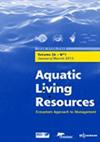采用传统的孵化场设备大规模饲养欧洲冶炼厂(Osmerus eperlanus, L.)的第一步
IF 1.9
4区 农林科学
Q3 FISHERIES
引用次数: 0
摘要
溯河鲈(Osmerus eperlanus)是湖泊和河流生态系统的重要物种。据报道,在过去和现在,一些栖息地的种群数量下降。其原因尚不清楚。对生命早期阶段的实验研究可以帮助揭示潜在的原因。为此,需要有关早期生命阶段人工繁殖和饲养的知识。根据以前的工作,我们展示了如何使用传统的孵化场设备扩大和大规模欧洲后冶炼厂,并提出了简化的首次饲养方案。臭蛋在去除粘着力后,可在水产养殖常用的标准孵卵设备中孵育。在麦当劳式的罐子中孵育,当防止漂浮的鸡蛋沉淀时,结果甚至有所改善。除了避免卵子流失,这同时减少了日常护理的劳动。幼虫的首次饲养可以通过去除青蒿囊来实现,从而消除了对劳动密集型绿水生产的需要。利用所提出的方案,可以大量生产不同阶段的幼虫,从而进行进一步的实验研究。本文章由计算机程序翻译,如有差异,请以英文原文为准。
First steps towards mass rearing of European smelt (Osmerus eperlanus, L.) using conventional hatchery equipment
Anadromous European smelt (Osmerus eperlanus) is a keystone species in lake and river ecosystems. In the past and present, stock declines in several of its habitats have been reported. The reasons for this are unclear. Experimental research on the early life stages could help to reveal the potential causes. For this purpose, knowledge on artificial propagation and rearing of early life stages is needed. Following from previous work, we show how to scale up and mass rear European smelt using conventional hatchery equipment and present a simplified protocol for first feeding. Smelt eggs, after egg adhesiveness is removed, can be incubated in standard hatchery equipment commonly used in aquaculture. Incubation in McDonald-type jars shows even improved results when settling of floating eggs is prevented. Next to avoiding egg loss this simultaneously reduces labor for daily care. First feeding of larval smelt can be achieved with decapsulated artemia cysts, eliminating the need for the labor-intensive green water production. Using the protocol presented, larvae of different stages can be produced in large quantities allowing further experimental studies.
求助全文
通过发布文献求助,成功后即可免费获取论文全文。
去求助
来源期刊

Aquatic Living Resources
农林科学-海洋与淡水生物学
CiteScore
2.30
自引率
0.00%
发文量
10
审稿时长
>24 weeks
期刊介绍:
Aquatic Living Resources publishes original research papers, review articles and propective notes dealing with all exploited (i.e. fished or farmed) living resources in marine, brackish and freshwater environments.
Priority is given to ecosystem-based approaches to the study of fishery and aquaculture social-ecological systems, including biological, ecological, economic and social dimensions.
Research on the development of interdisciplinary methods and tools which can usefully support the design, implementation and evaluation of alternative management strategies for fisheries and/or aquaculture systems at different scales is particularly welcome by the journal. This includes the exploration of scenarios and strategies for the conservation of aquatic biodiversity and research relating to the development of integrated assessment approaches aimed at ensuring sustainable and high quality uses of aquatic living resources.
 求助内容:
求助内容: 应助结果提醒方式:
应助结果提醒方式:


